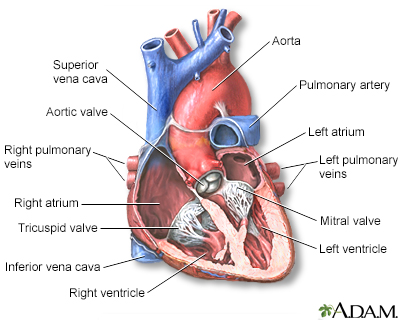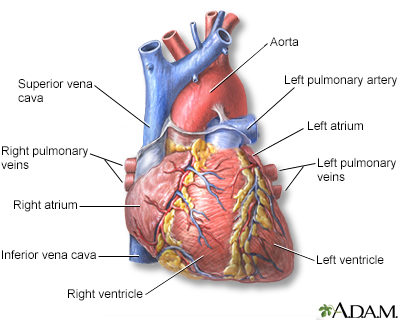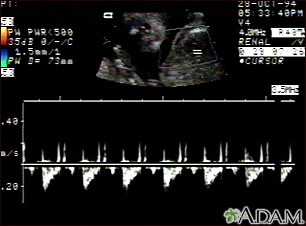Congenital heart disease
Congenital heart disease (CHD) is a problem with the heart's structure and function that is present at birth.
Images




Presentation

I Would Like to Learn About:
Causes
CHD can describe a number of different problems affecting the heart. It is the most common type of birth defect. CHD causes more deaths in the first year of life than any other birth defects.
CHD is often divided into two types: cyanotic (blue skin color caused by a lack of oxygen) and non-cyanotic. The following lists cover the most common CHDs:
Cyanotic:
- Ebstein anomaly
- Hypoplastic left heart
- Pulmonary atresia
- Tetralogy of Fallot
- Total anomalous pulmonary venous return
- Transposition of the great vessels
- Tricuspid atresia
- Truncus arteriosus
Non-cyanotic:
- Aortic stenosis
- Bicuspid aortic valve
- Atrial septal defect (ASD)
- Atrioventricular canal (endocardial cushion defect)
- Coarctation of the aorta
- Patent ductus arteriosus (PDA)
- Pulmonic stenosis
- Ventricular septal defect (VSD)
These problems may occur alone or together. Most children with CHD do not have other types of birth defects. However, heart defects may be part of genetic and chromosomal syndromes. Some of these syndromes may be passed down through families.
Examples include:
- DiGeorge syndrome
- Down syndrome
- Marfan syndrome
- Noonan syndrome
- Edwards syndrome
- Trisomy 13
- Turner syndrome
Often, no cause for the heart disease can be found. CHDs continue to be investigated and researched. Drugs such as retinoic acid for acne, chemicals, alcohol, and infections (such as rubella) during pregnancy can contribute to some congenital heart problems.
Poorly controlled blood sugar in women who have diabetes during pregnancy has also been linked to an increased rate of congenital heart defects.
Symptoms
Symptoms depend on the condition. Although CHD is present at birth, the symptoms may not appear right away.
Defects such as coarctation of the aorta may not cause problems for years. Other problems, such as a small VSD, ASD, or PDA may never cause any problems.
Exams and Tests
Most congenital heart defects are found during a pregnancy ultrasound. When a defect is found this way, a pediatric heart doctor, surgeon, and other specialists can be there when the baby is delivered. Having medical care ready at the delivery can mean the difference between life and death for some babies.
Which tests are done on the baby depend on the defect and the symptoms.
Treatment
Which treatment is used, and how well the baby responds to it, depends on the condition. Many defects need to be followed carefully. Some will heal over time, while others will need to be treated.
Some CHDs can be treated with medicine alone. Others need to be treated with one or more heart procedures or surgeries.
Prevention
Women who plan to become pregnant should be immunized against rubella if they are not already immune. Rubella infection in a pregnant woman can cause CHD.
Women who are pregnant should get good prenatal care:
- Avoid alcohol and illegal drugs during pregnancy.
- Tell your health care provider that you are pregnant before taking any new medicines.
- Have a blood test early in your pregnancy to see if you are immune to rubella. If you are not immune, avoid any possible exposure to rubella and get vaccinated right after delivery.
- Pregnant women who have diabetes should try to get good control over their blood sugar level.
Certain genes may play a role in CHD. Many family members may be affected. Talk to your provider about genetic counseling and screening if you have a family history of CHD.
Related Information
Coarctation of the aortaVentricular septal defect
Blue discoloration of the skin
Tetralogy of Fallot
Transposition of the great arteries
Tricuspid atresia
Total anomalous pulmonary venous return
Truncus arteriosus
Hypoplastic left heart syndrome
Atrial septal defect (ASD)
Patent ductus arteriosus
Aortic stenosis
Pulmonic valve stenosis
Trisomy 13
Turner syndrome
Marfan syndrome
Noonan syndrome
Ellis-van Creveld syndrome
Rubella
Fetal alcohol syndrome
References
Valente AM, Dorfman AL, Babu-Narayan SV, Kreiger EV. Congenital heart disease in the adolescent and adult. In: Libby P, Bonow RO, Mann DL, Tomaselli GF, Bhatt DL, Solomon SD, eds. Braunwald's Heart Disease: A Textbook of Cardiovascular Medicine. 12th ed. Philadelphia, PA: Elsevier; 2022:chap 82.
Well A, Fraser CD. Congenital heart disease. In: Townsend CM Jr, Beauchamp RD, Evers BM, Mattox KL, eds. Sabiston Textbook of Surgery. 21st ed. St Louis, MO: Elsevier; 2022:chap 59.
BACK TO TOPReview Date: 10/23/2023
Reviewed By: Michael A. Chen, MD, PhD, Associate Professor of Medicine, Division of Cardiology, Harborview Medical Center, University of Washington Medical School, Seattle, WA. Also reviewed by David C. Dugdale, MD, Medical Director, Brenda Conaway, Editorial Director, and the A.D.A.M. Editorial team.

Health Content Provider
06/01/2025
|
A.D.A.M., Inc. is accredited by URAC, for Health Content Provider (www.urac.org). URAC's accreditation program is an independent audit to verify that A.D.A.M. follows rigorous standards of quality and accountability. A.D.A.M. is among the first to achieve this important distinction for online health information and services. Learn more about A.D.A.M.'s editorial policy, editorial process and privacy policy. A.D.A.M. is also a founding member of Hi-Ethics. This site complied with the HONcode standard for trustworthy health information from 1995 to 2022, after which HON (Health On the Net, a not-for-profit organization that promoted transparent and reliable health information online) was discontinued. |
The information provided herein should not be used during any medical emergency or for the diagnosis or treatment of any medical condition. A licensed medical professional should be consulted for diagnosis and treatment of any and all medical conditions. Links to other sites are provided for information only -- they do not constitute endorsements of those other sites. © 1997- 2025 A.D.A.M., a business unit of Ebix, Inc. Any duplication or distribution of the information contained herein is strictly prohibited.
